|
from 10 march 2002 blue vol II, #24 |
|
|||
|
Munich 2002 by Marta Gregorcic
The protest taking place from February 1-3 was
supported by around 5000 demonstrators from Germany,
Italy, Austria, Poland, the Netherlands, France,
Switzerland, Slovenia, Croatia...
As the manifestations were legally forbidden, the first
demonstrators protested already on January 31 in main
square Marienplatz against the ban of the announced
manifestations. The police made the support on the
streets impossible. Buses travelling from Austria to
Munich were prevented from reaching their destination,
same happened to cars.
Because of the police repression and untiring
legitimation processes, the content of the
manifestation was not presented by means of banners
but rather orally, by means of speeches, public
argumentations, and printing material (leaflets,
posters, booklets).
There was listed a number of so
far existing (military) actions of NATO or its members
- from the Oil War in Iran before half of the century
till the recent attack on Afghanistan and its left
devastation. Moreover, they called our attention to
the German foreign policy and to Schroeder's support
of the military policy regardless of
"military risks", they demanded from the leaders, who claim democracy,
to stop making advantage of the people and to stop
tyrannizing for their own interest, they claimed that
the power of the world leaders gets support mostly
from people's indifference, passivity and uncertainty,
what world system reflects at present, they showed
that capitalism plays its final role and that
international solidarity and activism for the better
world are the only alternative.
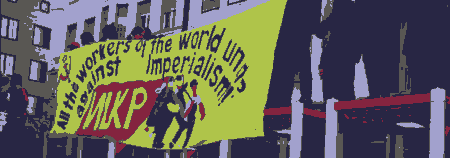
Friday: February 1, 2002: Raids in the morning; Marienplatz revives in the evening. Because of the support to the like-minded cosmopolitans and because of the clear refusal of the momentary political and economic conditions within the present world paradigm, my colleague and I stepped Friday morning on to the streets of Munich. Additionally, we wanted to present the content of the manifestations to the public (my colleague on the student station "Radio Student" and by means of the pictures, myself with the publications and presentations). Regular police examinations, passport checking, emptying of backpacks and questioning started at once. In the information centre the organisers gave us planners of the events in those three days, cityplans, printing material about the past events and those still to come in Munich and elsewhere, they told us whom to contact if we got arrested and in case of needing medical help, gave us place and time schedule of manifestations, carnivals and after-parties and they took care of our accommodation. The organisation was brilliant. In the afternoon, more and more demonstrators approached the square Marienplatz (the main place in the city) where the first manifestation was to begin at 5pm. The police kept stopping us, the atmosphere on the streets, however, was alluding the opposite. Manifestations for peace! The square Marienplatz was full of policemen in uniforms (about 100) and of policemen in plain-clothes. The last tried to hide themselves in the crowd but we recognized them because of their intruding conversation. And also the demonstrators and the journalists quickly drew our attention to them. At about 5.30pm everything was near its peak. The crowd was getting bigger and it started to integrate. The demonstrators started to stick posters on their backs claiming Wir sind keine Demonstranten (We are not demonstrators) or - as the police constantly identified them - Ich bin eine Demonstration... und finde uberall statt (I am a demonstration... I take place everywhere).
The manifestations continued with the slogans like Demo-Verbot, ha, ha, ha!, (Demonstration ban, ha, ha, ha!), Wir wollen nur friedlich demonstrieren (We want to protest peacefully), Frieden uberall bringt die NATO jetzt zu Fall (Peace brings NATO down), No justice - no peace! or Ohne Gerechtigkeit gibt es kein Frieden, Hoch die internationale Solidaritet (Go for the international solidarity), Deutsche Waffen, deutsches Geld morden in der ganzen Welt (German arms, German money kill all over the world) etc. The warning "Achtung, Achtung, hier spricht die Polizei!" (Attention please. This is the police speaking!) tried to spoil the enthusiasm, however, the demonstrators whistled at the police orders every time. The square Marienplatz was getting full of all kinds of policemen in uniforms (even the intervention forces were present) and they forcefully pushed the demonstrators from the square towards Zweibrucke Street. Every now and then they even tried to force their way into the crowd, they pushed the demonstrators apart and violently dragged them into buses and vans. Even policemen in plain-clothes tried to persuade us that we were not allowed to sit on the square (the pushing was getting horrible) and kept taking away our booklets and leaflets saying it was too dangerous to have them.
Every time when the police forced its way into the crowd, the demonstrators began to yell Keine Gewalt! Keine Gewalt! (No violence!), Wir sind das Volk (We are the people!), Wir sind friedlich, was seid Ihr?! (We are peaceful, not you!), Wir wollen nur friedlich demonstrieren (We want to protest peacefully), This is how democracy looks like! The police tried to disperse the crowd and they even succeeded but it integrated again, yelling Die Mauer muss weg! (The wall has to fall!), Eins, zwei, drei, lass die Leute frei! (One, two, three, let the people free!). At 9pm, policemen wearing white "capitan" caps tried to convince the rest of the demonstrators to leave the square Marienplatz. But with no success. Now there were even older people and in the meantime more than 150 demonstrators were arrested. Myself and my colleague left the square at around 9pm and we went to "No NATO Event" in Backstage ("free area", similar to Metelkova Street in Ljubljana, Slovenia), the abandoned industry building near the Donnersberger Brucke where many new clubs have been opened.
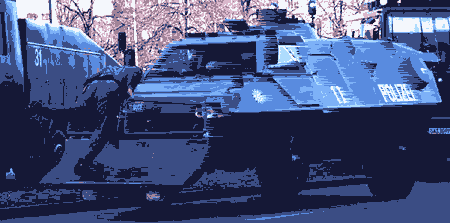
Saturday: February 2, 2002: All day manifestations concluded by the conference. The carnival in Marienplatz was about to start at 10am. The police set us an ultimatum: "Either you do not step on Marienplatz or you get arrested now". So we were allowed to move about 100 meters away from Marienplatz like the rest of the demonstrators who hadn't managed to get to the square. An hour or two later the majority managed to move in a circle of about 50 meters - into the immediate vicinity of the police line. At 2pm the crowd managed to break through the police line and a number of demonstrators joined the crowd from all sides. We marched through the city and there were about 5000 of us. Apart from students, pupils and the youth there were also older people, some with children, others with friends, even the handicaps and retired came. If the media, guessing whether the demonstrators were pacifists, activists or anarchists, were correct, they would report about people of all colours, races, strata. We were stopped by the first police line. We tried to get back to the main square but the police encircled 50 people. By yelling different slogans, we tried to convince the police to set them free. We built a kind of a bridge in the air - we threw those boxed in bottles of water, juice, fruit, sweets... Every time when police violently tried to push or take away the demonstrators, we started to shout and went to the place where tension was taking place. Inspite of the size of the crowd, communication and co-operation were brilliant between demonstrators. The captured group was pushed by the police to one way and another and the police tried to take them away. 5000 voices were shouting Eins, zwei, drei, lass die Leute frei (One, two, three, let the people free!), Wir sind friedlich, was seid Ihr? (We are peaceful, not you?!), Keine Gewalt, keine Gewalt! (No violence!).
Viva la revolution! Also those 50 boxed in joined us as the police got confused by our behaviour. Stories repeated. The police set us the lines and tried to separate the crowd into smaller groups, however, we managed after an hour or two to overcross the Schengen borders without violence. We continued with our march towards the building where Nato conference was being held. The demonstrators marched the whole day on the streets near the main square, but they couldn't come any further. The police kept stopping us in front of McDonalds so that the demonstrators could show their real intentions. Anyway, the pacifists weren't up to their tricks and the streets remained clean. The street carnival was to end at 9pm when we were again stopped by the police line. This time we weren't encircled, but they didn't let us to carry on with our march. We sat on the street and lit up candles at the police barricade. There were again policemen wearing white "capitan" caps. The demonstrators started to enummerate arguments and one police officer even stepped on our side and we heartily applauded him. The crowd slowly dispersed but not because of tiredness after twelve hours of manifestations. We went to the main railway station in smaller groups and headed for the "conference centre" where the conference against militarism was to be held and where we would analyse the manifestations and reflect upon the events of the last days. An open discussion and a microphone were there for all participants of the manifestation and also for the rest of the public. However, the journalists weren't interested in the discussion part of the manifestations.

But look, surprise, surprise! The police prevented us from entering the legally approved conference. The police lines pushed us from the conference centre. I joined some 100 demonstrators in front of one of the line. We could see "those boxed in" in front of the building from miles away. But soon even the communication through the police barricades was impossible for the demonstrators. The police lines started to grow even behind the backs of the groups. My group was suddenly divided into three smaller groups, one of them being on the right side. The members of the group on the right side were arrested eventually. The others went home, but we, the third group were there left on the left side. So the thirty of us insisted. The group was co-ordinated by one of the co-organizers from Munich. This time we marched with our hands raised from the third side and began shouting "Without Violence!". And we succeeded. About 100 police-officers, who prevented us from crossing the street, hadn't arrested us immediately. So, we sat down on the street again and our co-ordinator started to analyse the day events, our rights and the intention of the manifestations - from local reasons (i.e. German foreign policy) to global (world military paradigm). The German colleague warned the police that we would get up peacefully, approach them with our raised hand and that it would symbolize the freedom of movement and support to the encircled demonstrators and to those in front of the conference centre. We marched to the police with our raised hands chanting "Go for the international solidarity!" and then went back. Then we chanted and danced the dance "This is how democracy looks like!".
After an hour of performing "street theatre", the police line grew behind our backs and we quickly ranged into a line. With our hands raised and comical way of walking, we went to the next street. Even the police enjoyed our show and let us do it, thinking we were going home. However, we headed for the conference center - this time from the first side. Our group consisted now of about 40 to 50 people and we approached a new police line. We repeated the show but police was getting impatient. This time we couldn't be protected by the safety of cameras and photocameras and police vans were already ready to arrest us. Some demonstrators started to flee. In that moment everybody was trying to save their skin. I was saved by a Yugoslav citizen in front of a fast-food restaurant. In the narrow street also one of my colleagues came after me and we tried to analyse what had happened but with no success. In Marienplatz we found my colleague from Slovenia. We once again drove to the conference centre thinking there were still demonstrators being refused to enter the building. But the police was gone and the centre was opened. There were around 100 people. We caught the last minutes of the police conference where the demonstrators reflected upon the all day manifestations. When we returned home to Slovenia on Sunday, there was also an international conference held in Munich where the conditions in the third world countries were presented and where new manifestations were planned for spring. The content of the manifestations were irrelevant for the media. Even the interviews were not published. TZ Munchen, Abendszeitung, Suddeutsche Zeitung just moralized: "I care about my husband" and a photo of a lady with her child on half of the front page; "Men who protect Munich" and four policemen, their functions and their marital status (married, unmarried, how many children) were presented. A short article reported about the co-organizer of the manifestations, Claus Schreer, a freelance artist and an activist of the 68 generation (organizer of the manifestations against the war in Vietman, racism in Munich, etc.), bared his address and the age of his children (it called for physical and psychological maltreatment). Also Konstantin Wecker's statements (the local politician and the co-organizer of the manifestations) showed that the "violence had been used only by police". All three newspapers concluded that it had been only police that had been violent and they supported this judgement by photos.
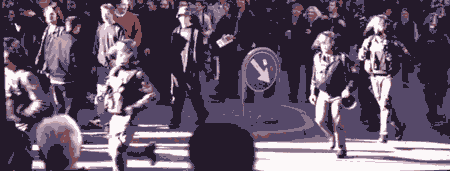
As I found out from my colleagues in Slovenia, there was almost no informing like at other manifestations. The content of the manifestations but today still remain hidden. Apart from the slogans called out by the demonstrators, the argumentation of the demonstrators in front of the police corridor carried the key meaning. The dialogue between police and demonstrators was dialogue with the public - the content with which the demonstrators tried to warn the public and the world military elite. After the actions in Seattle, Prague, Gothenburg and Genoa, also the manifestation in Munich proved once again that many of us do not approve of the present world leading manipulation. Capitalism raging is way beyond the borders of humanity. We fight against oppression, subjugation and cheating of people and there is plenty of us who would come back and neither police nor world military elite would stop us. We also proved that we can tightly co-operate on the streets without any big money, however, the world elite left Munich being unhappy and uncooperative. The booklet of the organisers says: "Let them beat us, put us in jails, terrorize us, they cannot stop us." Nothing can save the end of capitalism and nothing can stop our democratic warnings. The question which remains is when the privileged will confess it and when they will see the bodies they leave behind.
|
||

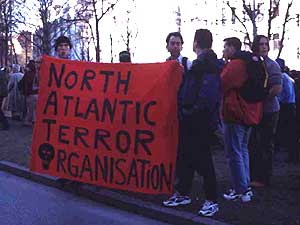
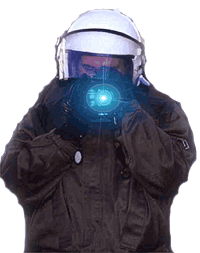 The target
of our peace campaigns [or "manifestations"] was again the
mis-use of the slogans
"the keeping of the peace" and
"security policy" used by the leaders for their
conference.
The target
of our peace campaigns [or "manifestations"] was again the
mis-use of the slogans
"the keeping of the peace" and
"security policy" used by the leaders for their
conference.
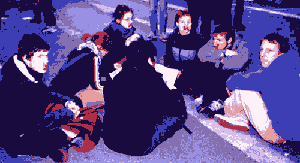 Others covered their mouths with
sticky tapes to tell at least two things - that they
are not allowed to speak and that the fact such
manifestations being forbidden, deserves no comment.
Longing for peace - does this mean a scandal in the
democracy? Three old ladies, assuring the police that
they would keep supporting such activities, held a
mascot of a hen, which was being strangled by a hand
holding an American flag. The organizers handed over a
number of booklets, leaflets, internet pages that drew
our attention to the lectures and events being held in
the next days or months about the international
solidarity, they told us where the
"revolutions" would
take place, they gave us presentation leaflets of some
organisations and activist groups, and the banners
started to wave.
Others covered their mouths with
sticky tapes to tell at least two things - that they
are not allowed to speak and that the fact such
manifestations being forbidden, deserves no comment.
Longing for peace - does this mean a scandal in the
democracy? Three old ladies, assuring the police that
they would keep supporting such activities, held a
mascot of a hen, which was being strangled by a hand
holding an American flag. The organizers handed over a
number of booklets, leaflets, internet pages that drew
our attention to the lectures and events being held in
the next days or months about the international
solidarity, they told us where the
"revolutions" would
take place, they gave us presentation leaflets of some
organisations and activist groups, and the banners
started to wave.
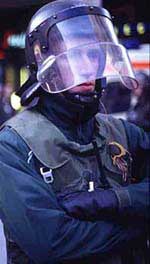 There were at least five kinds of police forces on the
manifestations. The white helmets (berets during the
day) were responsible for the security of the outer
ring, the green helmets (inner ring), however, had
direct contact to the demonstrators and mostly laid
violent hands on them. They forced their way into the
crowd like bulldogs and forcefully carried
demonstrators away. There were also the red berets but
they did not intervene. Every manifestation was ended
by the police wearing white "capitan" caps. Their
function was to tell demonstrators to separate
peacefully. I was surprised by the great number of
woman police officers. Almost one third of the police
unit were women and maybe that is why there wasn't any
serious violence, as the case was in Genoa. Cameramen
and photographers did their job brilliantly, they
elbowed their way through the crowd, took notes of
what was happening and later reported about it
(unfortunately they forgot the content of the
manifestations).
There were at least five kinds of police forces on the
manifestations. The white helmets (berets during the
day) were responsible for the security of the outer
ring, the green helmets (inner ring), however, had
direct contact to the demonstrators and mostly laid
violent hands on them. They forced their way into the
crowd like bulldogs and forcefully carried
demonstrators away. There were also the red berets but
they did not intervene. Every manifestation was ended
by the police wearing white "capitan" caps. Their
function was to tell demonstrators to separate
peacefully. I was surprised by the great number of
woman police officers. Almost one third of the police
unit were women and maybe that is why there wasn't any
serious violence, as the case was in Genoa. Cameramen
and photographers did their job brilliantly, they
elbowed their way through the crowd, took notes of
what was happening and later reported about it
(unfortunately they forgot the content of the
manifestations).
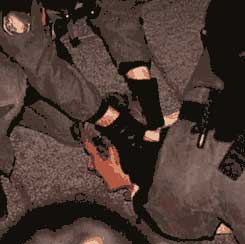 The demonstrators tried several times to prevent
surrounding by police and to save those boxed in but
with no success. The helicopter droned above our
heads, the police began to set up the outer ring. It
was clear that Friday mass arrests would repeat. The
countdown and our raised hands helped us to get
through the police line together and to run to the
centre.
The demonstrators tried several times to prevent
surrounding by police and to save those boxed in but
with no success. The helicopter droned above our
heads, the police began to set up the outer ring. It
was clear that Friday mass arrests would repeat. The
countdown and our raised hands helped us to get
through the police line together and to run to the
centre.
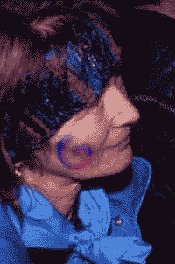 We again sat down and one of the demonstrators began
to read the Declaration of human rights and the German
constitution. After every introduction and every
reading of an article we applauded him and showed our
approval. We repeated "the theatre" twice. Then we
started to teach the police some articles from the
constitution and we began to shout
Samstag frei fur die Polizei! (Free Saturday for the police!). The
Turkish people were singing about freedom, two Germans
showed the killing of NATO by throwing themselves on
the floor. Passers-by approved of our show with
applause. We even gave some policemen bunch of flowers
as a present. The cameras and photocameras took
pictures of our foolery and they indirectly protected
us from the police. The journalists, cameramen and
photographers on the manifestations get great power of
support (informally of course) as their job results
present the only evidence. Statements of the
demonstrators have no value.
We again sat down and one of the demonstrators began
to read the Declaration of human rights and the German
constitution. After every introduction and every
reading of an article we applauded him and showed our
approval. We repeated "the theatre" twice. Then we
started to teach the police some articles from the
constitution and we began to shout
Samstag frei fur die Polizei! (Free Saturday for the police!). The
Turkish people were singing about freedom, two Germans
showed the killing of NATO by throwing themselves on
the floor. Passers-by approved of our show with
applause. We even gave some policemen bunch of flowers
as a present. The cameras and photocameras took
pictures of our foolery and they indirectly protected
us from the police. The journalists, cameramen and
photographers on the manifestations get great power of
support (informally of course) as their job results
present the only evidence. Statements of the
demonstrators have no value.